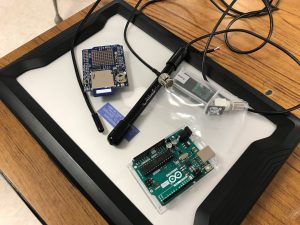Our grant application from the Gulf of Maine Research Institute was awarded and students are busy constructing a “remote salinity sensor station” that can digitally monitor the salinity of the marsh waters in the area near the outlet.
Contributed by Willow McConochie, Sophia Miller, Gwen Miller
Willow McConochie, James Cody, Jack Elwell, Sophia Miller, Gwen Miller, and Zeke Miller have been going up to the library every Thursday after lunch to work with Mr. Meinersmann to build a digital salinity sensor for the marsh. So far we have not done too much building, but we have been reading and learning about how the different parts work, and how they connect together. We will have to solder the circuit board and its wires to connect the probe and program the circuit board to collect data at specific time intervals. In order to do this we’ve been learning how to decipher code, and how to install it into the sensor to give it commands. After we are done building the sensor, we will test it indoors to see if it reads accurately before we put it into the marsh.
Testing the salinity of the marsh is important because research suggests there can only be five parts per thousand of salt in the marsh in order for alewive eggs to form properly. Last week we discovered that a tide greater than 10.3 feet will reach the outlet dam of the marsh. The only problem with that tide is that salt water will enter the marsh. Salt water will be able to reach the marsh. We wanted to be involved with this project because we thought it would be fun to build this sensor and find out how all of the different mechanisms work, and to explore more about the marsh.
 .
.  Note from Mrs. England
Note from Mrs. England
In the meantime, our class has been collecting water samples from the marsh to manually test for salinity differences. We used a refractometer and first tested a sample with distilled water and adjusted the scale to zero when needed. Then we tested our marsh sample at room temperature. We will be posting our data soon. Some of the highest tides in May are occurring this week and weekend, so it’s important we collect as many samples during this time as we can. Stay tuned!
 .
.
